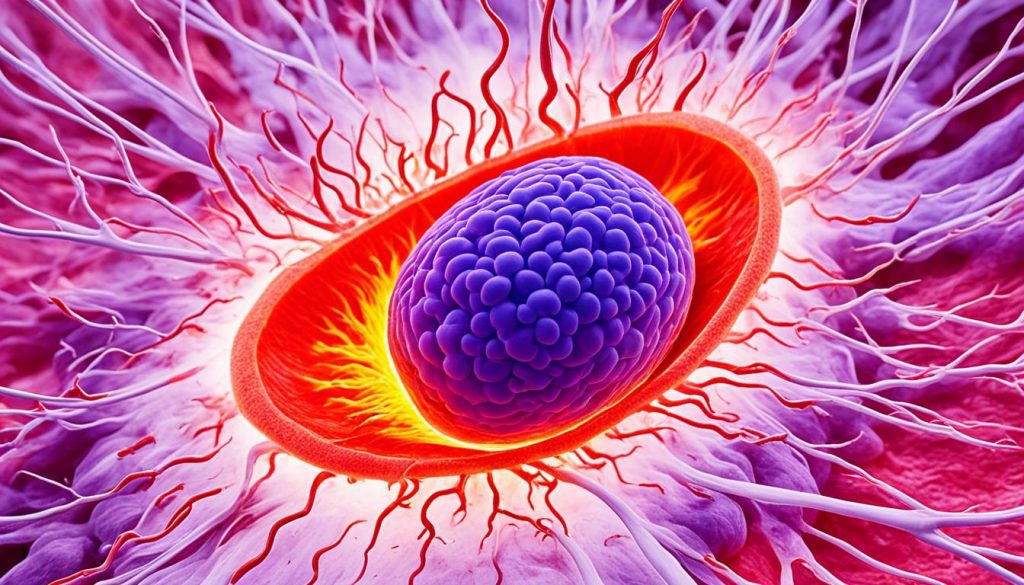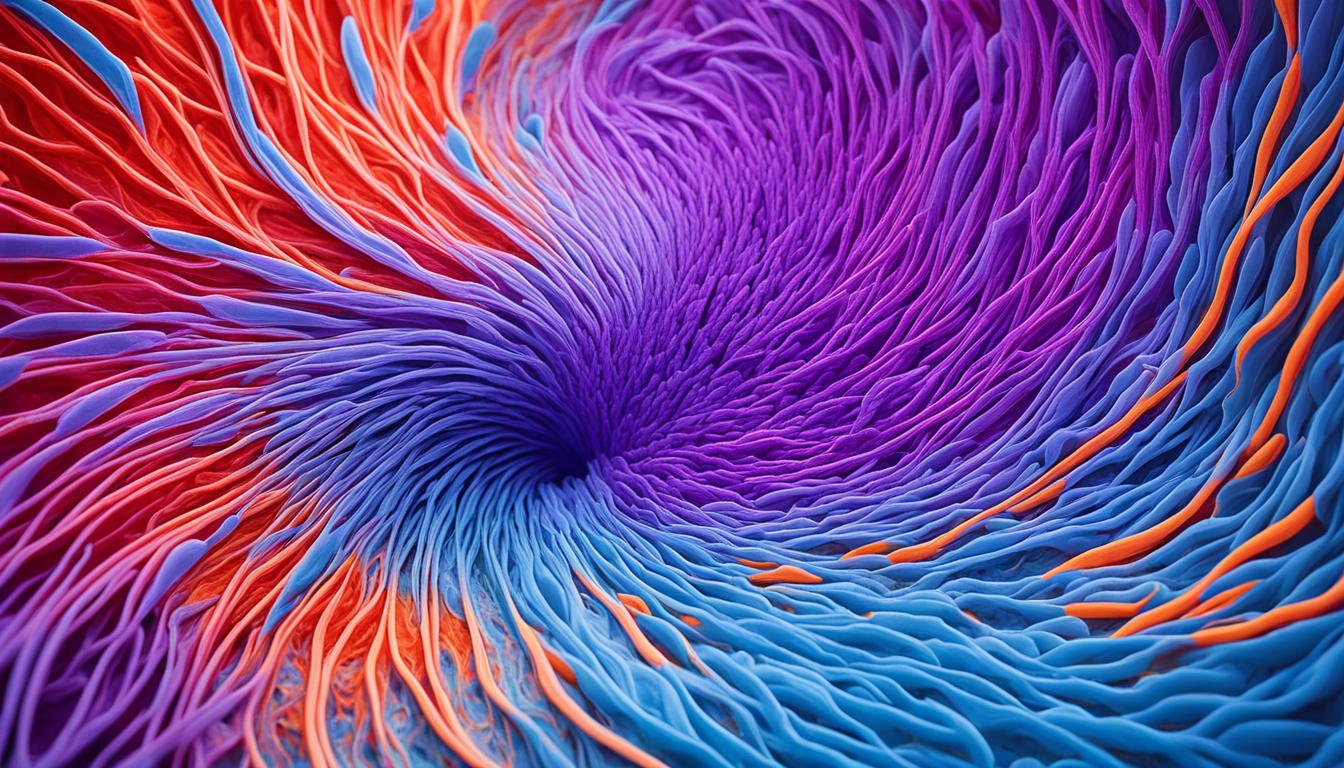Bladder inflammation, or cystitis, is a long-term condition that targets the urinary bladder. It leads to the bladder lining getting inflamed. This causes discomfort and a strong, frequent need to urinate. Since we don’t fully grasp what causes it, this condition is hard to pinpoint and treat. It can look a lot like other urinary issues.
This health issue can really affect someone’s day-to-day life. Not all treatments work the same for everyone. But, there’s hope with stem cell therapy. This approach could fix bladder damage and help patients feel better for longer. Now, in Thailand, many are turning to stem cell therapy for healing bladder inflammation.
Key Takeaways:
- Bladder inflammation, also known as cystitis or interstitial cystitis, is a chronic condition that affects the urinary bladder.
- Symptoms of bladder inflammation include discomfort, urgency, and frequency of urination.
- The exact causes of bladder inflammation are not fully understood.
- Stem cell therapy is an innovative treatment option for bladder inflammation that shows promise in repairing damaged tissue.
- In Thailand, stem cell therapy is gaining popularity as a treatment for bladder inflammation.
Understanding Interstitial Cystitis/Bladder Pain Syndrome
Interstitial cystitis is a chronic condition that affects the bladder. It causes chronic inflammation and symptoms like pain or discomfort in the bladder area. These symptoms can greatly affect a person’s life.
The reasons behind interstitial cystitis are complex and not fully known. It is thought to involve bladder inflammation, immune system reactions, and bladder wall problems. All these factors may play a role in this condition.
Diagnosing this condition can be tricky because it looks like other bladder issues. The process includes checking symptoms, physical exams, and special tests like cystoscopy. This test helps doctors see the bladder’s inside to check for inflammation.
Treating interstitial cystitis requires a team effort and a plan that suits the patient. Treatment may include changing some habits, bladder exercises, managing pain, physical therapy, and certain medications. These could be anti-inflammatory drugs or bladder treatments.
It’s key to remember that treatment varies from person to person. There is no single solution for everyone. Finding the right treatment plan is crucial for reducing symptoms and improving life quality.
Symptoms of Interstitial Cystitis/Bladder Pain Syndrome
| Common Symptoms | Additional Symptoms |
|---|---|
|
|
If you have symptoms of interstitial cystitis, seeing a doctor is vital. Early help and the right care can make a big difference in your wellbeing.
Anatomy of the Bladder and its Role in Inflammation
The bladder, a crucial part of the urinary system, sits in the pelvis. It’s in front of the rectum for both genders and near the uterus in females. The bladder stores urine until it’s released. It has four layers: the mucosa, submucosa, muscularis layer, and fibrous connective tissue.
The mucosa is the inner layer of the bladder, made of transitional epithelium. This lets the bladder stretch when it fills with urine. The mucosa also makes substances that protect the bladder lining.
Next is the submucosa, under the mucosa. It helps the bladder stretch and shrink, which is key for passing urine.
The muscularis layer makes the bladder contract to push out urine. It’s made of smooth muscle fibers that activate when you need to pee.
The outermost layer is the fibrous connective tissue, except on the top where the peritoneum is. This layer keeps the bladder strong and in shape.
The trigone is a triangular area in the bladder. It’s found between the ureteral openings and the urethral opening. It’s crucial for controlling urine flow and stopping urine from going back into the ureters.
Understanding the bladder’s structure is key for its function. If something goes wrong with these parts, inflammation and urinary problems can happen.
Layers of the Bladder
| Layer | Description |
|---|---|
| Mucosa | Contains transitional epithelium; allows bladder stretch and produces protective glycosaminoglycans |
| Submucosa | Aids in bladder elasticity and stretch |
| Muscularis Layer | Responsible for bladder contraction and emptying |
| Fibrous Connective Tissue Layer | Provides support and protection to the bladder |
Etiology and Pathophysiology of Bladder Inflammation
The causes of bladder inflammation are complex. They come from different factors. The exact reason isn’t fully known, but it’s linked to an inflammation process inside. People with this condition have higher levels of inflammation markers. This shows an immune system response and more activity in sensory nerves.
Cystoscopy might show glomerulations on the bladder lining. These are tiny hemorrhages. The presence of mast cells is also seen. Mast cells release substances that boost the inflammation and the symptoms patients feel.
Sometimes, bladder inflammation leads to fibrosis. This condition happens when too much collagen gathers in the bladder. Fibrosis can change the bladder’s structure. It makes the bladder hold less urine and causes more symptoms.
Bladder inflammation can also cause urothelial dysfunction. This means the bladder’s protective lining doesn’t work right. It can lead to increased bladder permeability and impaired barrier function. These issues add to the ongoing inflammation and symptoms.
Many factors play a role in bladder inflammation. These include genetic predisposition, autoimmune processes, chronic stress, and neurogenic inflammation. Genes can make someone more likely to get this condition. Autoimmune responses and chronic stress can keep the inflammation going. Neurogenic inflammation happens when nerves are damaged or not working right.
Understanding the causes and how bladder inflammation works is crucial. It helps in creating effective treatments and helps patients feel better.

Factors influencing etiology and pathophysiology of bladder inflammation
| Factor | Role |
|---|---|
| Genetic predisposition | Influences susceptibility to bladder inflammation |
| Autoimmune processes | Trigger and perpetuate the inflammatory response |
| Chronic stress | Contributes to the pathophysiology of bladder inflammation |
| Neurogenic inflammation | Causes inflammation due to nerve damage or dysfunction |
Epidemiology and Prevalence of Bladder Inflammation
Bladder inflammation affects many people. Yet, it’s hard to know exactly how many because it’s tough to diagnose. Studies show it’s more common in women than men.
About 2.7% of women and 1.9% of men have bladder inflammation. But these numbers may be too low. That’s because doctors often miss or misdiagnose it.
Having bladder inflammation is hard on a person. It can lead to constant discomfort and the need to urinate often. These problems can really disrupt someone’s life and happiness.
Finding this condition early can make a big difference. Knowing more about it helps doctors treat it better. It also means they can give specific advice and support to those who are suffering.
We need more studies to understand how widespread bladder inflammation is. This will make it easier to diagnose accurately. Raising awareness about this condition is key. It will help focus on stopping it before it starts, catching it early, and managing it well.
Prevalence of Bladder Inflammation
| Population Group | Prevalence (% of Population) |
|---|---|
| Women | 2.7% |
| Men | 1.9% |
Conclusion
Bladder inflammation is also called cystitis or interstitial cystitis. It’s a chronic problem that can really impact someone’s life. The reasons behind it are not fully known, which makes it hard to diagnose and treat. But, there’s new hope thanks to stem cell therapy.
Stem cell therapy is an exciting new way to treat bladder inflammation. It uses the body’s own cells to fix damaged bladder tissue. This could offer long-term comfort to those suffering. Thailand is leading in this area, with treatments showing promising results.
To better fight bladder inflammation, healthcare workers need to understand it better. This means learning more about what causes it and how it affects the body. The aim is to make life better for those dealing with this condition. With stem cell therapy and new research, the future looks brighter for treatment.

